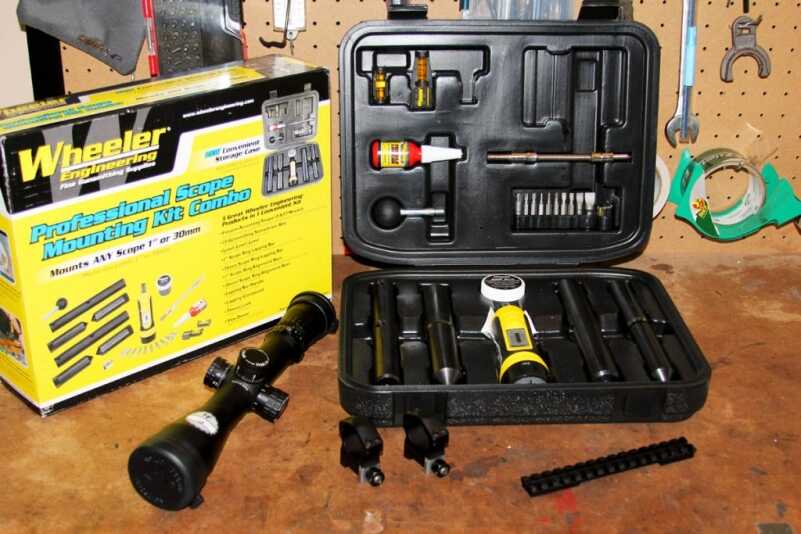
This scope mounting kit has everything that is needed to mount scope bases and rings from just about any manufacturer.
Purchase the product reviewed in this piece by clicking this link:
To enter the Midsouth Shooters’ GunsAmerica Giveaway contest, click this link:
There are few things on this earth as satisfying as successfully completing a project with your own two hands. Little gunsmithing projects invoke some of the same feelings and one of the most basic skills is correctly mounting a scope. It’s not hard to do but when it is done right you can go from a bench top full of parts to a rifle that’s capable of shooting accurately at long distances.
Just as with any project the best way to approach it is by starting out with the right tools for the job, otherwise, there’s the potential to do more harm than good. On that note, the kind folks at Midsouth Shooters Supply sent me the Wheeler Engineering Professional Scope Mounting Kit, which contains everything needed to correctly mount a scope whether you are a nascent hobbyist or a seasoned gunsmith.
The first thing you’ll notice when you get your hands on it is that it is hefty and when you open it up you’ll see why. Inside the blow-molded plastic case is a space for a torque wrench, bubble levels, thread locker, lapping bars, alignment bars, even an attachment that lets you connect the lapping bars to a drill.
What I like about the Wheeler Engineer kit is that it makes everything pretty foolproof because it gives you just what you need. The adjustable torque wrench gives you the ability to calibrate properly so you don’t run the risk of breaking screws off. Likewise, they give you a thread locker that will work so you don’t accidentally go off and use the wrong kind thus making it next to impossible to remove any screws. Alignment problems? They have the tools for that too.

Use a degreasing agent to clean out the screw holes in the action in addition to the screws and any bearing surfaces.
Although the tools may come from far-flung parts of the world I don’t get the sense that they’re low-quality parts. The FAT wrench, for example, has a very positive connection when the bit fits into the tip, you feel and hear the magnet snapping it into place. When I made the adjustments I could feel the tension of the spring inside but it didn’t beat me up when I turned it to the upper limits of the torque rating. There’s not much that can be said for the lapping and alignment bars other than they were well machined with no burrs or rough edges. I also liked that both levels have magnets in their bases to help keep them in place on scopes, bases, and actions.
I’m quite happy with this kit, I might not tote the whole thing everywhere but it’s earned a place under my bench. So with all that stuff out of the way let’s get down to actually using it to mount a scope from start to finish.
Mounting the Scope
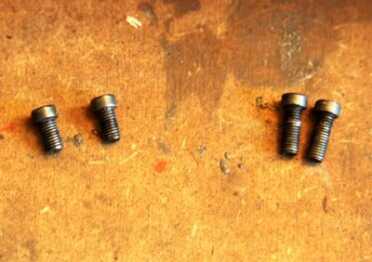
Make sure you keep base screws organized so that you know which screw goes where. If you inadvertently put one of the long screws in the front you could prevent the bolt from working properly.
First things first I advise you to always degrease everything when it comes out of the package or after it’s been removed from another rifle. If there are any residual oils or grease then any thread locker that you use won’t cure properly and screws could end up backing out under recoil. Flip the scope base over and add a thin coat of thread locker to the bottom of the base where it will contact the action. This doesn’t glue the base to the action but it creates a seal to prevent moisture from wicking underneath the base and rusting. Place the base back on the action and align the screw holes in the base with those on the action.
If everything checks out, dab a bit of thread locker onto the end of the screws before inserting them into the screw holes. Wheeler included purple thread locker, which is a low strength thread locker perfectly suitable for scope mounts. By using this agent screws can be easily removed with hand tools without much fuss. Start tightening down the screws alternating from front to back until you begin to feel resistance with the FAT Wrench. Set the torque wrench to 15 in/lbs and again start tightening the screws alternating from front to back until you hear the “click.” Take a q-tip and get any excess thread locker that got squeezed out from under the base or ended up on top of the base.

Always use properly fitting bits helps to prevent slippage and potential damage. The Wheeler kit has an assortment of bits that will work with a variety of fasteners.
Next, set the rings on the scope base and push them all the way forward in the slot before you tighten the cross bolt down to a finger-tight tension. Setting the rings in this fashion will ensure that the rings will not shift under recoil. There are no rules for where the rings should be positioned, sometimes it’s determined by the type of base used and other times it’s simply user preference.
Once you are happy with the positioning of the rings begin to tighten them down using the amount of torque recommended by the manufacturer. This amount can vary from 30-65 in/lbs so always double check before you proceed so you don’t damage the rings. You can use the alignment bars included in the kit to check the rings but in my experience quality rings with a quality base typically don’t experience any issues.
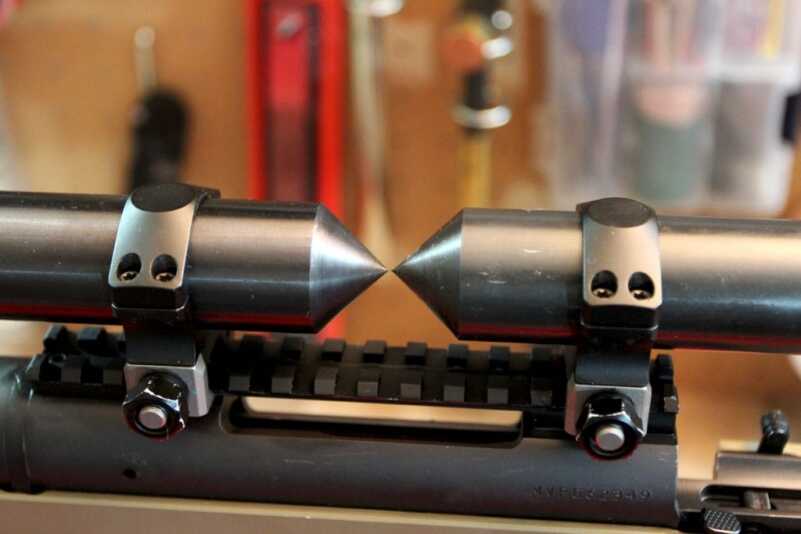
Using a good quality base and rings keeps everything aligned and working smoothly these wheeler alignment bars indicate that everything is good to go.
With all of that done you are ready to set the scope in the rings and get it level with the action using the Level-Level-Level system. This system uses two levels, one placed inside the action and another placed on top of the scope’s elevation turret to get the two plum with each other. Check your eye relief and reposition the scope as necessary to get a clear, crisp edge all the way around the field of view.
[one_half]
[/one_half]
[one_half_last]
[/one_half_last]
After you’ve double checked the eye relief and made sure the reticle is still level. replace the ring caps and begin tightening them. The general rule of thumb for ring cap screws is 15 in/lbs, tightening in an alternating pattern going from one side to the other, very similar to tightening the lug nuts on a car. When it’s done correctly, there should be an even gap on both sides of the rings and you’re all set to head out to the range and zero the scope.
Lapping The Rings

Ring cap screws are tightened to a 15-inch pounds and attention is paid to the bubble level to make sure the scope doesn’t rotate in the process.
There are certain types of rings and certain situations when it may become necessary to lap a set of scope rings. Lapping the rings can increase the surface area that comes into contact with the scope and it can correct minor alignment issues, especially with two piece bases. The Wheeler Engineering kit has you covered with a complete set of 1″ and 30 mm lapping bars.
The process isn’t complicated but it takes some patience. Start with the rings mounted and the ring caps removed so that you can smear an amount of lapping compound inside the rings. Place the lapping bar in the rings and replace the ring caps, tightening down the screws to the point where lapping bar is just able to move. Begin moving the lapping bar back and forth and side to side to start lapping the bearing surfaces of the rings. As the lapping bar starts to move more freely, tighten the ring cap screws some more and continue.
Periodically you’re going to have to clean off the lapping compound to inspect your progress. Take care not to mix up the ring caps, you want to make sure that the ring for the front stays up front; mixing them up can cause misalignment. There’s no specific time for how long it should take to lap a set of rings, but, ideally, you’ll want to see about 80% of the original finish removed from the inside of the rings.
[one_half]
[/one_half]
[one_half_last]

A job well done. With the right tools and know-how, this old .22 has a fresh set of eyes! Happy shooting.
[/one_half_last]
After you’ve successfully lapped the rings make sure that you clean every bit of lapping compound from the rings, ring cap screws, and screw holes. It’s very abrasive so you don’t want it to end up between the scope and the ring or falling into the action. You can then mount the scope in the rings and use the same procedures as above to level the scope and tighten down the screws.
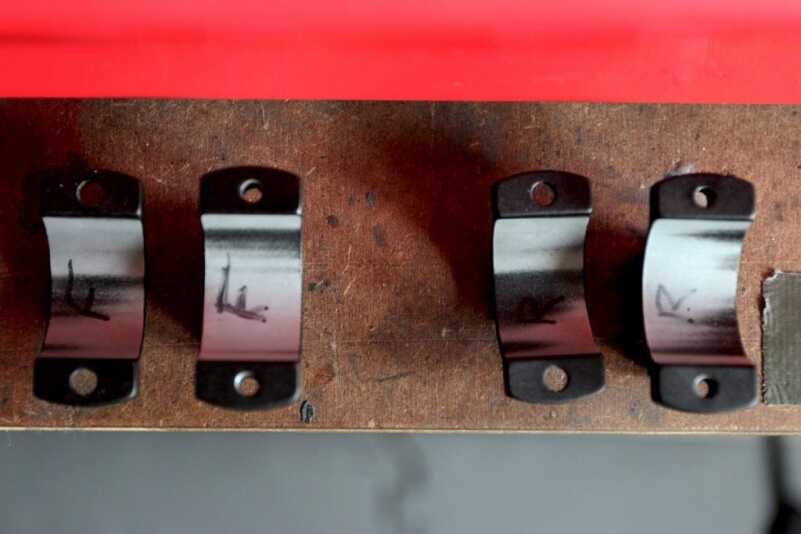
It’s a good idea to mark lapped rings so they can be paired with the bottom portion. The marks on the inside of the ring stay hidden after mounting.
Mounting a scope yourself is an easy and rewarding skill that can lead to you doing other home gunsmithing projects. Midsouth Shooters Supply and Wheeler Engineering have made the process easier by bundling all of the tools you might need into one convenient package. I urge you to get out there and learn how to do little gunsmithing projects on your own because a knowledgeable shooter is a better shooter. As always be safe, shoot, and be happy.
MIDSOUTH SHOOTERS’ GUNSAMERICA GIVEAWAY
Midsouth Shooters is a great resource for products like the above pieces at great prices. The company is offering you the chance to win one of the items covered in this and future GunsAmerica articles on Midsouth’s products. Just click the link, and gain tons of entries right up until the giveaway scheduled for 11-23-16. In addition, you can receive a free copy of the 240-page Reloading and Shooting Supply catalog from Midsouth Shooters! For more than 45 years, Midsouth Shooters has provided reloaders and shooters top-quality supplies and great prices. Click on the link and sign up to receive your free copy. See why so many shooters across the country shop at Midsouth Shooters.
To enter the Midsouth Shooters’ GunsAmerica Giveaway contest, click this link:
To purchase the products reviewed in this piece, click these links:


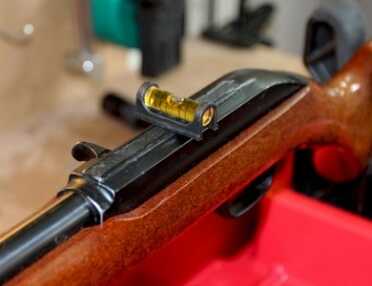
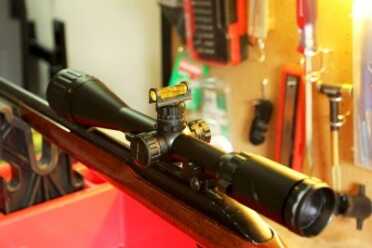

My AR-10’s all use one piece scope mounts.
Quite a savings and quicker to install!
Great kit but the plastic levels are junk. When I complained they were kind enough to send me two more. One was true the other was junk and I sent it back asking for one that was true. I have not heard from them and it has been two weeks.
Think I will leave it to the pros. Was an expert in the army with an M1. 60 years ago. My fingers say leave it to the pros.